Drones are an increasingly popular tool in today’s society, not only for civilians in their recreational activities, but also for law enforcement in the course of their duties.
Several months ago, a 47-year-old Cambridge woman with learning disabilities went missing. In an effort to find her, police deployed a drone to scan and survey nearby areas. She was found unharmed within the span of a few days. Similar events unfolded when a missing man with dementia in Perth County was found using a drone. There have been numerous cases, local or otherwise, where small surveillance drones have been used by law enforcement agents to locate individuals in a similar manner.
While the idea of police drones patrolling the skies may sound like something out of a George Orwell novel, local drone experts in the field aren’t too worried currently about the possibility of drones infringing on citizens’ privacy.
Derek Robinson, an assistant professor at the University of Waterloo, found the concept laughable.
“Definitely not in Canada,” Robinson stated. “The applications I’ve seen have been to document and gain insight about traffic accidents after they have happened or to use thermal imagery to guide search and rescue teams.”
Robinson further elaborated, “While it’s possible that law enforcement could sit a remotely piloted aircraft on a building and use the camera for information collection, there is already a wide array of cameras in public and surveillance approaches that are more subtle than sending a high-pitched remotely piloted aircraft through a neighbourhood.”
Robinson’s department uses drones in aviation, geomatics and geography programs (all available at the University of Waterloo), which provide a valuable education on drones and drone data.
Adam Stephens, a digital media marketing specialist at Aeryon Labs (one of the foremost drone manufacturers in Canada) said about police surveillance drones, “We imagine that deployment and usage regulations will be much the same as any other tool used by law enforcement agencies currently. Documentation and approvals are all checks and balances put in place to ensure that the privacy and freedoms of citizens in a nation remain protected.”
On the topic of possible regulations, Robinson said, “Surveillance operations will be limited to what is achievable in “plain view” and major emergency response teams.”
Law enforcement drones are not the only ones to have regulations put on them. On the topic of civilian drone usage, Stephens released this statement: “Transport Canada is currently reviewing and modifying their requirements for recreational users that will include a test for the pilot, liability insurance, and other regulations.”






























